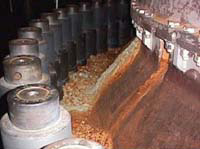
The two largest nuclear power utilities, Exelon and Entergy, aren’t the only ones looking for ratepayer bailouts for uneconomic power plants. Add Ohio’s FirstEnergy to the list, which is seeking subsidies that the Ohio Consumers Counsel puts at $3 Billion to keep its Davis-Besse reactor and some old, decrepit coal plants operating.
The portion for Davis-Besse alone is at least $171 million/year and NIRS estimates that the actual price tag may be $225 million/year above the market rate for electricity.
Ohioans are not happy with the prospect of such rate increases. As the Cleveland Plain-Dealer reported yesterday, some 200 people crammed into a Public Utilities Commission of Ohio (PUCO) hearing in Cleveland “to vent rage about the company’s latest rate proposal, and at times, its actions over the last decade.”
As is the case elsewhere, some of FirstEnergy’s power plants, especially the Davis-Besse reactor and the Sammis coal plant, can’t compete with lower cost natural gas and wind power. Since FirstEnergy doesn’t own those gas and wind plants, it wants ratepayers to pay the much higher costs of keeping Davis-Besse and Sammis open.
And as was the case in Illinois, the Nuclear Energy Institute (NEI) jumped in with a study claiming that operating Davis-Besse through 2037 (although its license expires in 2017 and it has not yet received an extension; its application for an extension is being contested) would provide $30 Billion in economic activity for the state. NEI also claims that there are not only 700 jobs at the reactor, but its operation “stimulates” nearly 4600 more jobs in the area.
Of course NEI did not examine what would happen if Davis-Besse closed and its power were replaced by renewable sources. Renewable energy typically provides far more jobs per megawatt/hour of electricity produced than nuclear power. In Illinois, the state agencies charged with defending Exelon’s claims about its troubled reactors determined instead that closing reactors would lead to new jobs and new clean energy generation. The same almost certainly would be true in Ohio.

And NEI claimed (and presumably its economic figures are based on the notion) that “Davis-Besse is a highly reliable source of electricity,” pointing to its 98% capacity factor in 2013. What NEI did not mention is that Davis-Besse historically has been one of the most safety-troubled reactors in the country, responsible for two of the NRC’s five most serious safety events since Three Mile Island. The result of these problems–and there are still significant safety issues at the reactor, including cracking in its shield building–is that, through 2012, Davis-Besse’s lifetime capacity factor was 67.6%, according to the World Nuclear Association–one of the lowest figures for a reactor in the country.
In short, reliability is not exactly a selling point for Davis-Besse. Counting on one of its best years to be its norm for the next 30 years is somewhat akin to jumping into a car with a broken gas gauge for a long road trip and assuming the tank is full. Are you feeling lucky?
At the Cleveland hearing, a number of speakers said they would be willing to pay more for renewable-powered electricity–but not for Davis-Besse or coal plants. But that’s a problem in Ohio, which is the only state in the country that reversed its renewable energy and energy efficiency standards. That stance, taken last year by a right-wing state legislature, already has cost a lot of jobs in the state, according to a report released last week from Pew Charitable Trusts, based on work from the consulting firm Navigant Research.
The American Legislative Exchange Council (ALEC), a far-right organization devoted to changing state laws across the country, waged a major, but mostly unsuccessful, campaign last year to overturn Renewable Energy Standards in numerous states. Only Ohio bit, and now it’s paying for that decision. Clean energy investment is fleeing the state to build elsewhere, meaning that replacing Davis-Besse with renewables would not be as easy as it would in most states.
But another fact NEI ignored in its “study” is that Davis-Besse accounts for only 5% of the state’s overall generation; its shutdown wouldn’t even be noticed. And that leaves plenty of time for the state’s energy policies to change again and for renewables to again be an important part of the state’s energy future. Indeed, a Davis-Besse shutdown might be just the thing needed to spur reconsideration of the RES and bring in a new era of clean, affordable energy for Ohio.
Michael Mariotte
January 22, 2015
Permalink: https://www.nirs.org/2015/01/22/firstenergy-wants-a-big-bailout-too/
Your contributions make publication of GreenWorld possible. If you value GreenWorld, please make a tax-deductible donation here and ensure our continued publication. We gratefully appreciate every donation of any size.
Comments are welcome on all GreenWorld posts! Say your piece above. Start a discussion. Don’t be shy; this blog is for you.
If you’d like to receive GreenWorld via e-mail, send your name and e-mail address to nirs@nirs.org and we’ll send you an invitation. Note that the invitation will come from a GreenWorld@wordpress.com address and not a nirs.org address, so watch for it.
If you like GreenWorld, you can help us reach more people. Just use the icons below to “like” our posts and to share them on the various social networking sites you use. And if you don’t like GreenWorld, please let us know that too. Send an e-mail with your comments/complaints/compliments to nirs@nirs.org. Thank you!
GreenWorld is crossposted on tumblr at https://www.tumblr.com/blog/nirsnet




Ohio will be an example for other states NOT to follow. Overturning Renewable Standards is Not in the best interests of the state. Time will prove this out.
Indeed!
In addition, Ohio citizens keep on shooting themselves in the foot by electing reactionary state legislators. Not the swiftest state in the Union. Meanwhile they are also accustomed to continuous generous federal subsidies to big ag., as in other states in the so-called “Heartland” (often printed as a proper noun–LOL). I think another part of the human anatomy better represents this region, but hesitate to name it here.
More problems at the WIPP –big piece of the roof fell: http://www.currentargus.com/carlsbad-news/ci_27374646/wipp-discovers-fallen-roof-during-inspection
Meanwhile our true-believer President makes deals promoting more NPPs with the Indian leader, Modi. When is Obama going to wise-up?
Sammis is not an “old decrepit coal plant”. The plant has modern scrubbers and selective catalytic reduction, and is extremely clean. Environmentalists would rather us trade coal generation with it’s above-ground issues which can be dealt with, for fracked natural gas generation with its attendant potential for drinking water aquafier contamination. Once an aquafier is contaminated, there is nothing that can be done to fix it. As usual, many environmentalists aren’t playing with a full deck, and their sensationalist propaganda gets in the way of actual scientific fact.
Actually, environmentalists want coal plants (and nuclear reactors) replaced with the clean energy technologies of the 21st century: distributed renewables, smart grid, energy efficiency, and all the technological advances that now make those able to provide the power we need without carbon emissions, radioactive waste, nuclear meltdown and environmental devastation caused by extraction and, in nuclear’s case, a dirty fuel chain.
Or maybe you haven’t actually bothered to read this blog?